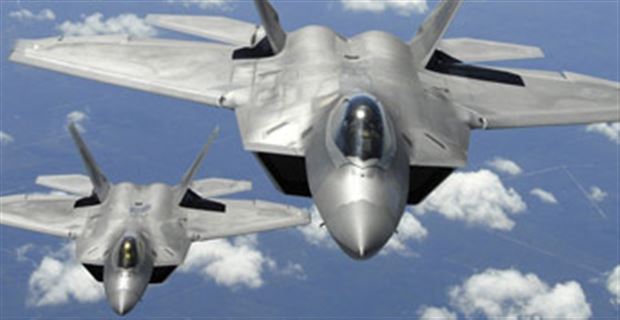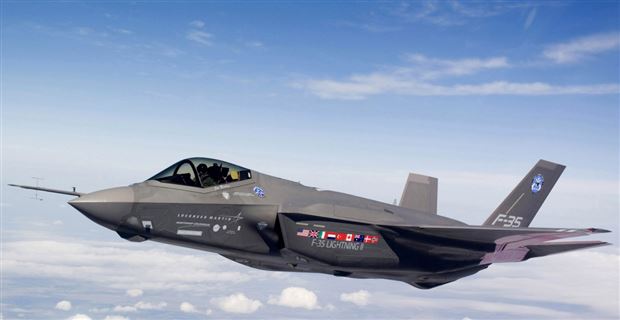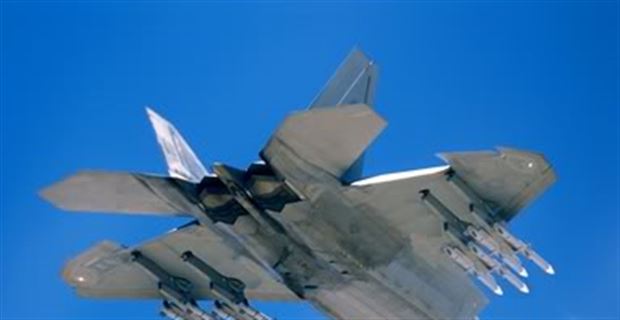تخضع الان طائرة الــ F22 الي اختبارات تشغيلية مكثفة استعدادا لترقيات كبري تشمل العتاد الداخلي للطائرة وقدرات الاستهداف جو صح من حواضن والكترونيات ومستشعرات بالإضافة الي تحديث في البرنامج التشغيلي للمقاتلة لاستيعاب الصواريخ الجديدة من طراز AIM 120D و B 2 AIM9X بالاضافة الي وصلات بيانات متوافقة مع طائرة F35
The Air Force is now conducting operational tests of new software and weapons technology for the F-22 designed to help modernize the stealth fighter and expand the range of weapons it is able to fire in combat, service and industry officials said.
Air Force officials have told Scout Warrior that, by 2019, the service will begin upgrading F-22 functionality for the AIM-120D and AIM-9X Air-to-Air missiles as well as enhanced Air-to-Surface target location capabilities. The F-22 currently carries the AIM-9X Block 1 and the current upgrade will enable carriage of AIM-9X Block 2.
By Kris Osborn
Current operational testing of the F-22 is focused upon a 3.2B software upgrade for the fighter, allowing it to quickly integrate weapons upgrades, Air Force officials said.
"The F-22 Increment 3.2B program is a hardware and software upgrade to enhance the lethality of the F-22 through the employment of the AIM-120D and AIM-9X missiles. Recent testing enabled the program to complete developmental flight test and enable its entry into the Initial Operational Testing and Evaluation (IOT&E) phase of the program. During this phase, tests are conducted on production representative aircraft to determine whether the upgrade is operationally effective and suitable for intended use by pilots and maintenance personnel. The results of IOT&E will support the decision to proceed into full rate production," Capt. Emily Grabowski, Air Force spokeswoman, told Scout Warrior.
Raytheon AIM-9X weapons developers explain that the Block 2 variant adds a redesigned fuze and a digital ignition safety device that enhances ground handling and in-flight safety. Block II also features updated electronics that enable significant enhancements, including lock-on-after-launch capability using a new weapon datalink to support beyond visual range engagements, a Raytheon statement said.
Another part of the weapons upgrade includes engineering the F-22 to fire the AIM-120D, a beyond visual range Advanced Medium-Range Air-to-Air Missile (AMRAAM), designed for all weather day-and-night attacks; it is a "fire and forget" missile with active transmit radar guidance, Raytheon data states. The AIM-120D is built with upgrades to previous AMRAAM missiles by increasing attack range, GPS navigation, inertial measurment units and a two-way data link, Raytheon statements explain.
The most recent contract award was to Raytheon Missile Systems as the prime contractor in Sep 2017, for software upgrades that will continue to improve the performance of the AIM-120D in an electronic attack environment, Grabowski said.
"The AMRAAM program continues to increase capability through planned software upgrades to ensure the family of missiles remains viable against ever-evolving threats," Grabowski added. "As the most recent AMRAAM missile for the Air Force, the AIM-120D, was operationally fielded in 2015, as a small, light, fast missile with improved capabilities against very low and high-altitude targets in an electronic attack environment.
As the Air Force and Lockheed Martin move forward with weapons envelope expansions and enhancements for the F-22, there is of course a commensurate need to upgrade software and its on-board sensors to adjust to emerging future threats, industry developers explained. Ultimately, this effort will lead the Air Force to draft up requirements for new F-22 sensors.
An essential software adjustment is now being worked on by Lockheed Martin engineers on contract with the Air Force. Work on the software is slated to be finished by 2020, developers added.
A hardware portion of the upgrades, called a “tactical mandate,” involves engineering new antennas specifically designed to preserve the stealth configuration of the F-22.
New antennas have to be first constructed and retrofitted onto the airplane. Because of the stealth configuration putting, antennas on is difficult and time consuming," Lockheed officials said.
The Air Force is in the early phases of designing new sensors for its stealthy 5th-generation F-22 Raptor as it proceeds with software upgrades, hardware adjustments, new antennas and data link improvements designed to better enable to connect the F-22 and F-35 sensor packages to one another, industry and Air Force officials said.

Sensor interoperability, two-way data links and other kinds of technical integration between the two 5th-Gen stealth aircraft are considered key to an Air Force combat strategy which intends for the F-22 speed and air-to-air combat supremacy to complement and work in tandem with the F-35's next-gen sensors, precision-attack technology, computers and multi-role fighting mission ability.
While the F-35 is engineered with dog-fighting abilities, its advanced sensor technology is intended to recognize enemy threats at much further distances - enabling earlier, longer-range attacks to destroy enemies in the air. Such technologies, which include 360-degree sensors known as Northrop Grumman's Distributed Aperture System and a long range Electro-Optical Targeting System, are designed to give the F-35 an ability to destroy targets at much longer ranges - therefore precluding the need to dogfight.
Like the F-35, the latest F-22s have radar (Synthetic Aperture Radar) and data-links (F-22 has LINK 16), radar warning receivers and targeting technologies. Being that the F-22 is regarded as the world's best air-to-air platform, an ability for an F-35 and F-22 to more quickly exchange sensor information such as targeting data would produce a potentially unprecedented battlefield advantage, industry developers and Air Force senior leaders have explained. The combined impact of each of the airplanes respective technological advantages makes for an unrivaled air-combat supremacy, observers have argued.
For example, either of the aircraft could use stealth technology to penetrate enemy airspace and destroy air defense systems. Once a safe air corridor is established for further attacks, an F-22 could maintain or ensure continued air supremacy while an F-35 conducted close-air-support ground attacks or pursued ISR missions with its drone-like video-surveillance technology. Additionally, either platform could identify targets for the other, drawing upon the strengths of each.

Conversely, an F-35 could use its long-range sensors and "sensor fusion" to identify airborne targets which the F-22 may be best suited to attack.
Air Force developers are, quite naturally, acutely aware of the Chinese J-20 stealth fighter and Russia's PAK-FA T-50 stealth aircraft as evidence that the US will need to work vigorously to sustain its technological edge.
Along these lines, both the F-22 and F-35 are engineered to draw from "mission data files," described as on-board libraries storing information on known threats in particular geographical locations. This database is integrated into a radar warning receiver so that aircraft have the earliest possible indication of the threats they are seeing.
Meanwhile, the Air Force is performing key maintenance on the F-22 Raptor's stealth materials while upgrading the stealth fighter with new attack weapons to include improved air-to-air and air-to-surface strike technology, service officials said.
The AIM-120D also includes improved High-Angle Off-Boresight technology enabling the weapon to destroy targets at a wider range of angles.
Additional upgrades to the stealth fighter, slated for 2021, are designed to better enable digital communications via data links with 4th and 5th generation airplanes.
--- To Read Previous Scout Warrior Coverage of F-22 Upgrades and Pilot Interviews - CLICK HERE --

Stealth Coating Maintenance
The Air Force has contracted Lockheed Martin to perform essential maintenance to the F-22's low-observable stealth coating to ensure it is equipped to manage fast-emerging threats.
Lockheed Martin completed the first F-22 Raptor at the company’s Inlet Coating Repair (ICR) Speedline, a company statement said.
"Periodic maintenance is required to maintain the special exterior coatings that contribute to the 5th Generation Raptor’s Very Low Observable radar cross-section," Lockheed stated.
The increase in F-22 deployments, including ongoing operational combat missions, has increased the demand for ICR. Additionally, Lockheed Martin is providing modification support services, analytical condition inspections, radar cross section turntable support and antenna calibration.
F-22 Attack & Supercruise Technology
At the moment, targeting information from drones is relayed from the ground station back up to an F-22. However, computer algorithms and technology is fast evolving such that aircraft like an F-22s will soon be able to quickly view drone video feeds in the cockpit without needing a ground station -- and eventually be able to control nearby drones from the air. These developments were highlighted in a special previous Scout Warrior interview with Air Force Chief Scientist Greg Zacharias.
Zacharias explained that fifth generation fighters such as the F-35 and F-22 are quickly approaching an ability to command-and-control nearby drones from the air. This would allow unmanned systems to deliver payload, test enemy air defenses and potentially extend the reach of ISR missions.
Newer F-22s have a technology called Synthetic Aperture Radar, or SAR, which uses electromagnetic signals or “pings” to deliver a picture or rendering of the terrain below, allow for better target identification.
The SAR technology sends a ping to the ground and then analyzes the return signal to calculate the contours, distance and characteristics of the ground below.
The F-22 is known for a range of technologies including an ability called “super cruise” which enables the fighter to reach speeds of Mach 1.5 without needing to turn on its after burners.
The fighter jet fires a 20mm cannon and has the ability to carry and fire all the air-to-air and air-to-ground weapons including precision-guided ground bombs, such Joint Direct Attack Munitions called the GBU 32 and GBU 39, service weapons developers explained. In the air-to-air configuration the Raptor carries six AIM-120 AMRAAMs and two AIM-9 Sidewinders.
It also uses what’s called a radar-warning receiver – a technology which uses an updateable data base called “mission data files” to recognize a wide-range of enemy fighters, officials said.
Made by Lockheed Martin and Boeing, the F-22 uses two Pratt & Whitney F119-PW-100 turbofan engines with afterburners and two-dimensional thrust vectoring nozzles, an Air Force statement said. It is 16-feet tall, 62-feet long and weighs 43,340 pounds. Its maximum take-off weight is 83,500.
The aircraft was first introduced in December of 2005, and each plane costs $143 million, Air Force statements say.
The Air Force’s stealthy F-22 Raptor fighter jet delivered some of the first strikes in the U.S.-led attacks on the Islamic State in Iraq and Syria, when aerial bombing began in 2014, service officials told Scout Warrior.
After delivering some of the first strikes in the U.S. Coalition-led military action against ISIS, the F-22 began to shift its focus from an air-dominance mission to one more focused on supporting attacks on the ground.
Even though ISIS does not have sophisticated air defenses or fighter jets of their own to challenge the F-22, there are still impactful ways in which the F-22 continues to greatly help the ongoing attacks, service officials explained.
https://scout.com/military/warrior/...-Start-Building-Non-Nuclear-Stealth-109679473
The Air Force is now conducting operational tests of new software and weapons technology for the F-22 designed to help modernize the stealth fighter and expand the range of weapons it is able to fire in combat, service and industry officials said.
Air Force officials have told Scout Warrior that, by 2019, the service will begin upgrading F-22 functionality for the AIM-120D and AIM-9X Air-to-Air missiles as well as enhanced Air-to-Surface target location capabilities. The F-22 currently carries the AIM-9X Block 1 and the current upgrade will enable carriage of AIM-9X Block 2.
By Kris Osborn
Current operational testing of the F-22 is focused upon a 3.2B software upgrade for the fighter, allowing it to quickly integrate weapons upgrades, Air Force officials said.
"The F-22 Increment 3.2B program is a hardware and software upgrade to enhance the lethality of the F-22 through the employment of the AIM-120D and AIM-9X missiles. Recent testing enabled the program to complete developmental flight test and enable its entry into the Initial Operational Testing and Evaluation (IOT&E) phase of the program. During this phase, tests are conducted on production representative aircraft to determine whether the upgrade is operationally effective and suitable for intended use by pilots and maintenance personnel. The results of IOT&E will support the decision to proceed into full rate production," Capt. Emily Grabowski, Air Force spokeswoman, told Scout Warrior.
Raytheon AIM-9X weapons developers explain that the Block 2 variant adds a redesigned fuze and a digital ignition safety device that enhances ground handling and in-flight safety. Block II also features updated electronics that enable significant enhancements, including lock-on-after-launch capability using a new weapon datalink to support beyond visual range engagements, a Raytheon statement said.
Another part of the weapons upgrade includes engineering the F-22 to fire the AIM-120D, a beyond visual range Advanced Medium-Range Air-to-Air Missile (AMRAAM), designed for all weather day-and-night attacks; it is a "fire and forget" missile with active transmit radar guidance, Raytheon data states. The AIM-120D is built with upgrades to previous AMRAAM missiles by increasing attack range, GPS navigation, inertial measurment units and a two-way data link, Raytheon statements explain.
The most recent contract award was to Raytheon Missile Systems as the prime contractor in Sep 2017, for software upgrades that will continue to improve the performance of the AIM-120D in an electronic attack environment, Grabowski said.
"The AMRAAM program continues to increase capability through planned software upgrades to ensure the family of missiles remains viable against ever-evolving threats," Grabowski added. "As the most recent AMRAAM missile for the Air Force, the AIM-120D, was operationally fielded in 2015, as a small, light, fast missile with improved capabilities against very low and high-altitude targets in an electronic attack environment.
As the Air Force and Lockheed Martin move forward with weapons envelope expansions and enhancements for the F-22, there is of course a commensurate need to upgrade software and its on-board sensors to adjust to emerging future threats, industry developers explained. Ultimately, this effort will lead the Air Force to draft up requirements for new F-22 sensors.
An essential software adjustment is now being worked on by Lockheed Martin engineers on contract with the Air Force. Work on the software is slated to be finished by 2020, developers added.
A hardware portion of the upgrades, called a “tactical mandate,” involves engineering new antennas specifically designed to preserve the stealth configuration of the F-22.
New antennas have to be first constructed and retrofitted onto the airplane. Because of the stealth configuration putting, antennas on is difficult and time consuming," Lockheed officials said.
The Air Force is in the early phases of designing new sensors for its stealthy 5th-generation F-22 Raptor as it proceeds with software upgrades, hardware adjustments, new antennas and data link improvements designed to better enable to connect the F-22 and F-35 sensor packages to one another, industry and Air Force officials said.

Sensor interoperability, two-way data links and other kinds of technical integration between the two 5th-Gen stealth aircraft are considered key to an Air Force combat strategy which intends for the F-22 speed and air-to-air combat supremacy to complement and work in tandem with the F-35's next-gen sensors, precision-attack technology, computers and multi-role fighting mission ability.
While the F-35 is engineered with dog-fighting abilities, its advanced sensor technology is intended to recognize enemy threats at much further distances - enabling earlier, longer-range attacks to destroy enemies in the air. Such technologies, which include 360-degree sensors known as Northrop Grumman's Distributed Aperture System and a long range Electro-Optical Targeting System, are designed to give the F-35 an ability to destroy targets at much longer ranges - therefore precluding the need to dogfight.
Like the F-35, the latest F-22s have radar (Synthetic Aperture Radar) and data-links (F-22 has LINK 16), radar warning receivers and targeting technologies. Being that the F-22 is regarded as the world's best air-to-air platform, an ability for an F-35 and F-22 to more quickly exchange sensor information such as targeting data would produce a potentially unprecedented battlefield advantage, industry developers and Air Force senior leaders have explained. The combined impact of each of the airplanes respective technological advantages makes for an unrivaled air-combat supremacy, observers have argued.
For example, either of the aircraft could use stealth technology to penetrate enemy airspace and destroy air defense systems. Once a safe air corridor is established for further attacks, an F-22 could maintain or ensure continued air supremacy while an F-35 conducted close-air-support ground attacks or pursued ISR missions with its drone-like video-surveillance technology. Additionally, either platform could identify targets for the other, drawing upon the strengths of each.

Conversely, an F-35 could use its long-range sensors and "sensor fusion" to identify airborne targets which the F-22 may be best suited to attack.
Air Force developers are, quite naturally, acutely aware of the Chinese J-20 stealth fighter and Russia's PAK-FA T-50 stealth aircraft as evidence that the US will need to work vigorously to sustain its technological edge.
Along these lines, both the F-22 and F-35 are engineered to draw from "mission data files," described as on-board libraries storing information on known threats in particular geographical locations. This database is integrated into a radar warning receiver so that aircraft have the earliest possible indication of the threats they are seeing.
Meanwhile, the Air Force is performing key maintenance on the F-22 Raptor's stealth materials while upgrading the stealth fighter with new attack weapons to include improved air-to-air and air-to-surface strike technology, service officials said.
The AIM-120D also includes improved High-Angle Off-Boresight technology enabling the weapon to destroy targets at a wider range of angles.
Additional upgrades to the stealth fighter, slated for 2021, are designed to better enable digital communications via data links with 4th and 5th generation airplanes.
--- To Read Previous Scout Warrior Coverage of F-22 Upgrades and Pilot Interviews - CLICK HERE --

Stealth Coating Maintenance
The Air Force has contracted Lockheed Martin to perform essential maintenance to the F-22's low-observable stealth coating to ensure it is equipped to manage fast-emerging threats.
Lockheed Martin completed the first F-22 Raptor at the company’s Inlet Coating Repair (ICR) Speedline, a company statement said.
"Periodic maintenance is required to maintain the special exterior coatings that contribute to the 5th Generation Raptor’s Very Low Observable radar cross-section," Lockheed stated.
The increase in F-22 deployments, including ongoing operational combat missions, has increased the demand for ICR. Additionally, Lockheed Martin is providing modification support services, analytical condition inspections, radar cross section turntable support and antenna calibration.
F-22 Attack & Supercruise Technology
At the moment, targeting information from drones is relayed from the ground station back up to an F-22. However, computer algorithms and technology is fast evolving such that aircraft like an F-22s will soon be able to quickly view drone video feeds in the cockpit without needing a ground station -- and eventually be able to control nearby drones from the air. These developments were highlighted in a special previous Scout Warrior interview with Air Force Chief Scientist Greg Zacharias.
Zacharias explained that fifth generation fighters such as the F-35 and F-22 are quickly approaching an ability to command-and-control nearby drones from the air. This would allow unmanned systems to deliver payload, test enemy air defenses and potentially extend the reach of ISR missions.
Newer F-22s have a technology called Synthetic Aperture Radar, or SAR, which uses electromagnetic signals or “pings” to deliver a picture or rendering of the terrain below, allow for better target identification.
The SAR technology sends a ping to the ground and then analyzes the return signal to calculate the contours, distance and characteristics of the ground below.
The F-22 is known for a range of technologies including an ability called “super cruise” which enables the fighter to reach speeds of Mach 1.5 without needing to turn on its after burners.
The fighter jet fires a 20mm cannon and has the ability to carry and fire all the air-to-air and air-to-ground weapons including precision-guided ground bombs, such Joint Direct Attack Munitions called the GBU 32 and GBU 39, service weapons developers explained. In the air-to-air configuration the Raptor carries six AIM-120 AMRAAMs and two AIM-9 Sidewinders.
It also uses what’s called a radar-warning receiver – a technology which uses an updateable data base called “mission data files” to recognize a wide-range of enemy fighters, officials said.
Made by Lockheed Martin and Boeing, the F-22 uses two Pratt & Whitney F119-PW-100 turbofan engines with afterburners and two-dimensional thrust vectoring nozzles, an Air Force statement said. It is 16-feet tall, 62-feet long and weighs 43,340 pounds. Its maximum take-off weight is 83,500.
The aircraft was first introduced in December of 2005, and each plane costs $143 million, Air Force statements say.
The Air Force’s stealthy F-22 Raptor fighter jet delivered some of the first strikes in the U.S.-led attacks on the Islamic State in Iraq and Syria, when aerial bombing began in 2014, service officials told Scout Warrior.
After delivering some of the first strikes in the U.S. Coalition-led military action against ISIS, the F-22 began to shift its focus from an air-dominance mission to one more focused on supporting attacks on the ground.
Even though ISIS does not have sophisticated air defenses or fighter jets of their own to challenge the F-22, there are still impactful ways in which the F-22 continues to greatly help the ongoing attacks, service officials explained.
https://scout.com/military/warrior/...-Start-Building-Non-Nuclear-Stealth-109679473
